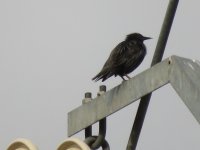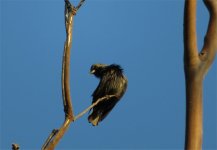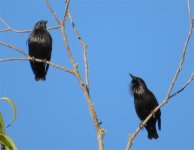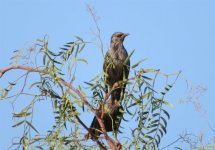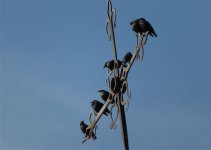Top 10 ID tips:
1.Spotless is a Common Starling which has had a bath in an oily puddle and forgot to preen. Then got a shower in molasses, soy sauce and marmite...
2. Spotless sings like Common. The first part only. Then, it's a bit alien and simplified. A bit like Brian Eno's stuff. and very quiet experimental jazz. But more quiet, than experimental. And you continually look for a volume knob to turn it up. But the first bit's freakin' loud after poor sleep and drinks around the pool last night!
3. Spotless, like Common, are really social. But instead of half a million going to roost, you'll probably get about 40 on large TV aerials feeling a bit shy and trying to keep the noise down as not to annoy the holiday-makers. Like a 6th form party at someone's parents' house, which was gonna be the Dog's, but only the Science Club turned up. And the house smelt funny...
4.The last Ice Age separated Common and Spotless and made one weird and the other spotty and a YouTube Bore!
5. They are the Starling version of Spotted Crake for UK birders who've never seen one. And imagine they'll be just like Water Rails. So, you think you've just seen a Common Starling, like back at home, but it's a bit X-Files-ish, and you feel you might have a psychosis.
6. They do not Murmurate. Only in rubbishly small groups... And it's a bit crap. Like throwing raisins at an old yellowing wedding dress...
7. They speak Spanish & Portuguese. Which is probably why their calls go unheeded by Linguophobes.
8. They are Spotless Starlings. And they are not countable as real birds, as they might not exist at all. In fact they don't. Like something you saw in the corner of your eye, which was just mascara, or just that bit of the corner of your eye, where you see stuff, and attempt to inflate your life-list, then your eye pops out...
9. When illustrating them in field guides they save money on paint.
10. You're probably not gonna see Common Starlings in Iberia until Autumn. And they will leave in Spring. That bit in the middle is SPOTLESS! :t:




